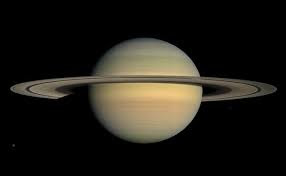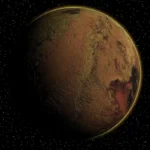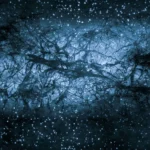
Many astronomers consider Saturn the most beautiful planet in the solar system because of its stunning rings. In fact, Saturn’s nickname is “the jewel of the solar system.”
Saturn is the second-largest planet in our solar system after Jupiter, which is about 20% larger than Saturn. Earth is the fifth-largest planet in our solar system.
Saturn is not the only planet with rings. Jupiter, Uranus, and Neptune also have rings, although they are much fainter and less spectacular than Saturn’s.
Saturn is the least dense planet in the solar system, and if there were a body of water large enough to hold Saturn, the planet would float. In contrast, Earth and Mercury would sink the fastest.
On July 1, 2004, the Cassini-Huygens was the first spacecraft to orbit Saturn. Launched on October 15, 1997, it traveled over 2,000,000,000 miles at a speed of 70,700 miles per hour before it reached the ringed planet. Its mission has been extended to 2012.
The first spacecraft to fly by Saturn was Pioneer 11, which blasted off in 1973 and arrived at Saturn in 1979. Voyagers 1 and 2 also completed fly-bys in 1980 and 1981. Voyager 1 is now the farthest human-made object in space.
Scientists believe that Saturn is approximately -350° F (-212° C). The coldest temperature ever recorded on Earth is -129° F (-89° C).
Saturn is 74,898 miles (120,537 km.) wide, nearly 10 times wider than Earth. Approximately 750 Earths could fit inside of Saturn.
Nearly 1,600 Saturns could fit inside the Sun.
A year on Earth is 365.256 days. A year on Saturn is 10,759.22 days.
A day on Earth is 24 hours. A day on Saturn is 10 hours 39 minutes.
Winds in Saturn’s atmosphere travel up to 1,100 miles (1,800 km.) per hour, much faster than those on Jupiter. The strongest tornadoes on Earth have reached speeds of only about 300 miles (483 km.) per hour.
Storms on Saturn can last for months or even years. A long-lived 2004 storm on Saturn, named the “Dragon Storm,” created mega-lightning 1,000 times more powerful than lightning on Earth.
In early 2010, amateur astronomers spotted a massive ammonia blizzard raging on Saturn. The monster storm is five times larger than “Snowmageddon,” the snowstorm that shut down Washington D.C. in February 2010.
The Assyrians, who lived in modern-day Iraq, were the first to record sighting Saturn in 700 B.C. They called the planet the Star of Ninib, after the Assyrian sun god of spring.
The planet Saturn is named after the Roman god of farming, Saturn, who was also the father of the Roman god Jupiter. The planet’s symbol is a sickle, a tool that belonged to the Roman god of harvest and was also the weapon Cronos used to castrate and depose his father, Uranus.
As the seventh day of the week, Saturday is named after Saturn, the farthest of the seven objects in the solar system known in ancient times.
Many of Saturn’s moons are named after the Titans, the giant brothers and sisters of the god Saturn. Others are named after Inuit, French, and Northern European giants.
Saturn rotates so fast (6,200 miles per hour) that the planet bulges at its equator and its poles are flat. It is the flattest (oblate) planet in the solar system. In fact, Saturn rotates faster than any other planet except for Jupiter.
Discovered in 1789 by William Herschel, Saturn’s moon Enceladus (named after the mythological giant) has geysers that erupt icy particles, water vapor, and organic compounds. It is the shiniest object in the solar system because its icy surface reflects most of the light it receives.
The geysers on Enceladus not only feed the rings around Saturn but also may contain “ingredients for life.” Only two other outer solar system objects have known active eruptions: Neptune’s moon Triton and Jupiter’s moon Io, which are believed to erupt nitrogen and sulfur, respectively.
Saturn’s largest moon, Titan, is the only known moon to have a substantial atmosphere, which is 370 miles deep, 10 times thicker than Earth’s atmosphere. Conditions on Titan may resemble ancient Earth conditions, though at a much lower temperature.
Saturn’s moon Titan is the second-largest moon in the solar system. Only Jupiter’s moon Ganymede (named after one of Zeus’ lovers) is larger. Titan is even bigger than Mercury.
Though Saturn’s rings weren’t discovered until the 1600s, some scholars theorize ancient cultures may have known about them. For example, the Maori in New Zealand have historically referred to Saturn as Parearau, an ancient name that means “surrounded by a headband.”
More than any other planet in our solar system, Saturn’s weather is determined by conditions deep in the planet rather than by the Sun. This is partly because Saturn is so far away from the Sun and generates heat internally.
Traveling to Saturn by car at 70 miles (117 km.) per hour would take 1,292 years when Saturn is closest to Earth. It would take 1,595 years when Saturn is at its farthest.
Because Saturn spins on a tilt, it has seasons. Summer on Saturn lasts about eight Earth years.
Saturn has no real surface. Gas merges gradually into a hot ocean of liquid hydrogen and helium. The planet’s core is a ball of rock, about the size of Earth.
The atmospheric pressure on Saturn is over 100 times greater than the Earth’s atmospheric pressure. The pressure is so powerful that it squeezes gas into liquid. It would crush any human-made spacecraft.
Saturn gives off more than twice as much heat as it receives from the Sun. Scientists believe Saturn generates heat when helium sinks slowly through liquid hydrogen deep inside the planet. In fact, the temperature at Saturn’s core is estimated to be about 21,150° F (11,700° C), which is almost as hot as the surface of the Sun.
On April 14, 2010, NASA’s Cassini orbiter captured images of lightning on Saturn, which allowed scientists to create the first movie showing lightning flashes on another planet. Lightning is common on Saturn, though the bolts run only from cloud to cloud, unlike the cloud-to-ground lightning on Earth.
Saturn’s ring system is very wide, spreading out over a distance of 175,000 miles (282,000 km.). If you traveled that distance from Earth, you would be more than halfway to the moon.
Saturn’s rings are only a few hundred feet thick, which is less than half the length of a football field.
Saturn’s rings are made from billions of chunks of rock and ice, ranging in size from a grain of sand to pieces as large as a house. They have a mysterious reddish “contaminant” that might be rust or the same organic material found in red vegetables on Earth.
Though it was once thought that they formed around the time of the dinosaurs, information gathered from the Cassini probe suggests that Saturn has had its rings throughout its history.
Only Jupiter has more moons (63) than Saturn (61), not counting Saturn’s hundreds of “moonlets.”
Because Saturn is so far from the Sun, the Sun would appear 10 times smaller viewed from Saturn than it does from Earth. On average, Earth receives 90 times more sunlight than Saturn.
Galileo Galilei was the first person to see Saturn through a telescope, in 1610. He thought the rings looked like “ears” and were “handles” or moons. In a secret anagram to his scientist friend Kepler, Galileo wrote he had discovered that the “highest planet” was “triple-bodied.”
The fifth-century B.C. text Surya Siddhanta approximated Saturn’s diameter at 73,580 miles. The calculation was only 1% off from the currently accepted estimate of 74,580 miles.
Scientists speculate that Saturn’s rings may disappear in 50 million years. Saturn’s gravitational pull will either suck the rings into the planet, or the rings will dissolve into space.
In astrology, Saturn is the opposite of Jupiter. Whereas Jupiter is associated with expansion, Saturn is associated with contraction. Saturn is concerned with boundaries, practicality, reality, and building/conforming to social structures.
At its farthest point from the Sun (aphelion), Saturn is approximately 940 million miles (1.51 billion km.) away. When it is at its closest (perihelion), Saturn is about 840 million miles (1.35 billion km.) from the Sun. On average, Saturn is about 891 million miles (1.4 billion km.) from the Sun. Earth, on average, is 92,935,700 miles (150 million km.) away.
Saturn has seven main rings that consist of thousands of smaller rings. The ring farthest from the planet, the E ring, is about 180,000 miles (300,000 km.) across. In contrast, the F ring is about 20-300 miles (30-500 km.) wide.
Saturn’s rings seem to disappear about every 14 years. Scientists believe that the rings seem to disappear when Saturn is tilted directly in line with Earth.
Saturn’s moon Titan is a very noisy place. The sound of the wind on Titan is intensified because Titan’s thick air conducts sound waves so well.
Saturn’s nearest moon takes just 12 hours to circle the planet. Its farthest moon takes more than three Earth years.
Saturn FAQs: Unveiling the Ringed Wonder
General
-
What is Saturn? Saturn is the sixth planet from the Sun and the second-largest planet in our solar system, known for its spectacular rings. It’s a gas giant, meaning it has no solid surface like Earth.
-
How big is Saturn? Saturn is a whopper! With an equatorial diameter of about 120,500 kilometers (74,897 miles), it’s roughly nine times wider than Earth. If Earth were the size of a nickel, Saturn would be about the size of a volleyball!
-
How far is Saturn from Earth? The distance between Earth and Saturn varies depending on their positions in their orbits. On average, Saturn is a whopping 1.4 billion kilometers (886 million miles) away from the Sun, which translates to roughly 9.5 astronomical units (AU). (An AU is the distance between the Sun and Earth.)
-
How long does a year on Saturn last? One year on Saturn, which is the time it takes for the planet to complete one orbit around the Sun, is much longer than a year on Earth. It takes Saturn a staggering 29.4 Earth years to make one trip around the Sun.
-
How long is a day on Saturn? This is where things get interesting! Saturn has the second-shortest day in the solar system. It rotates on its axis very quickly, completing a full rotation in just about 10.7 hours. That means a Saturnian day is less than half the length of an Earth day!
Rings
-
What are Saturn’s rings made of? Contrary to popular belief, Saturn’s rings aren’t solid. Instead, they are a massive collection of billions of icy particles, ranging in size from dust grains to boulders, all orbiting Saturn. These particles are mostly composed of water ice with some rocky debris mixed in.
-
How many rings does Saturn have? Saturn has a complex ring system, traditionally described as having seven main rings, though there are numerous smaller ringlets within them. The most prominent rings are the A, B, and C rings, visible from Earth with a small telescope.
-
Why can we see Saturn’s rings but not the rings of other gas giants? While other gas giants like Jupiter have rings, they are far less substantial and composed of much darker dust particles. Saturn’s rings are brighter and contain a higher proportion of ice, making them much more reflective and easier to see.
Atmosphere and Composition
-
What is Saturn’s atmosphere made of? Like most gas giants, Saturn’s atmosphere is primarily composed of hydrogen (around 96%) and helium (around 3%). Trace amounts of methane, ammonia, water vapor, and other hydrocarbons are also present. These atmospheric gases contribute to the planet’s yellow and gold colored bands.
-
Does Saturn have a solid core? Scientists believe Saturn has a solid core, most likely composed of iron, nickel, and rock, surrounded by a layer of liquid metallic hydrogen with a deeper layer of molten ice and rock. However, unlike Earth, this core is much smaller compared to the planet’s overall size.
Moons
-
How many moons does Saturn have? Saturn is the undisputed moon king! As of 2024, scientists have confirmed the existence of 82 moons orbiting Saturn, with many more small moons yet to be definitively identified. The largest moon, Titan, is even bigger than Mercury and has a thick atmosphere!
-
Are any of Saturn’s moons habitable? While none of the moons currently meet the conditions we believe are necessary for life as we know it, some, like Titan with its lakes and rivers of liquid methane, are of particular interest in the search for extraterrestrial life.
Exploration
- Has Saturn been visited by spacecraft? Yes! Several robotic spacecraft have explored Saturn, including Cassini, which spent over 13 years studying the planet and its rings in incredible detail. The ongoing Cassini mission revolutionized our understanding of Saturn and its moons.
These are just a few of the many fascinating aspects of Saturn. Astronomers continue to learn more about this ringed giant with each new mission and observation.









